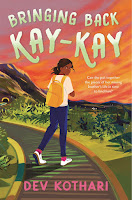October 1, 2024 by Walker Books US
E ARC provided by Edelweiss Plus
Lena has always struggled with her relationship with her older brother, Karthick. While he is generally nice to her, his mere existence seems to suck all of the air out of the room, and she feels that her parents don't care about her at all. When he goes missing on a train trip back to Lamora from summer camp in Goa, the entire family is devastated, especially since the police assume he has just run away. While her mother descends into a deep depression, Lena tries to interview Kay-Kay's friends and teachers, often running afoul of the police. She discovers some alarming things, like the fact that her brother's best friend Samir argued with her brother, and has Kay-Kay's phone. Not only that, but he's lying about it. Lena investigates Kay-Kay's room, and finds a lot of poetry in his backpack, which opens her eyes to new and different facets of her brother. Many of the poems are about friendship and how it alleviates loneliness, and Lena finds out that Kay-Kay was friends with Akash, a new boy in school who was badly injured in a science lab accident. When she can't get any answers, she decides to run away and take the train trip that her brother took. This is a dangerous thing to do, but she takes a bus, and does manage to find out things about her brother from people who talked to him. She also endangers herself, eventually ending up in the hospital having rushed into traffic. She's helped by a nice woman who calls her parents, but Lena is determined to keep investigating. Will she ever be able to find out what happened to her brother? (Spoiler: yes!)
Lena has always struggled with her relationship with her older brother, Karthick. While he is generally nice to her, his mere existence seems to suck all of the air out of the room, and she feels that her parents don't care about her at all. When he goes missing on a train trip back to Lamora from summer camp in Goa, the entire family is devastated, especially since the police assume he has just run away. While her mother descends into a deep depression, Lena tries to interview Kay-Kay's friends and teachers, often running afoul of the police. She discovers some alarming things, like the fact that her brother's best friend Samir argued with her brother, and has Kay-Kay's phone. Not only that, but he's lying about it. Lena investigates Kay-Kay's room, and finds a lot of poetry in his backpack, which opens her eyes to new and different facets of her brother. Many of the poems are about friendship and how it alleviates loneliness, and Lena finds out that Kay-Kay was friends with Akash, a new boy in school who was badly injured in a science lab accident. When she can't get any answers, she decides to run away and take the train trip that her brother took. This is a dangerous thing to do, but she takes a bus, and does manage to find out things about her brother from people who talked to him. She also endangers herself, eventually ending up in the hospital having rushed into traffic. She's helped by a nice woman who calls her parents, but Lena is determined to keep investigating. Will she ever be able to find out what happened to her brother? (Spoiler: yes!)
Strengths: This novel is set in India, and it's interesting to learn about school and summer camp details in that country. While Lena's life is very upper middle class, we do meet some characters, like Stan the Man, who live a very different life that will be hard for students in the US to imagine. (He lives in a train station and works for a tea seller to survive.) It's a good thing that Lena cares about her brother and undertakes an almost impossible trek to locate him. Readers who like poetry will enjoy reading the verses that Kay-Kay has written. The mother's situation is an interesting depiction of parental depression, most likely caused by post partum depression, something I haven't seen very much in middle grade literatue.
Weaknesses: Lena really does endanger herself frequently, and doesn't seem to have a well thought out plan for locating her brother, although she has a lot of good luck. The book is written as a letter to Kay-Kay, addressing him as "you", which sometimes seemed odd. Also, I was pretty sure for most of the novel that Kay-Kay has a crush on Akash and had committed suicide because he was gay. This is completely a "me" thing, although the poetry about being lovely is probably what led me to this thought. Certainly kept me reading to see what happened.
What I really think: This is a good choice for readers who like adventures prompted by family problems, like Bilan's Asha and the Spirit Bird and Rauf's The Star Outside.
Weaknesses: Lena really does endanger herself frequently, and doesn't seem to have a well thought out plan for locating her brother, although she has a lot of good luck. The book is written as a letter to Kay-Kay, addressing him as "you", which sometimes seemed odd. Also, I was pretty sure for most of the novel that Kay-Kay has a crush on Akash and had committed suicide because he was gay. This is completely a "me" thing, although the poetry about being lovely is probably what led me to this thought. Certainly kept me reading to see what happened.
What I really think: This is a good choice for readers who like adventures prompted by family problems, like Bilan's Asha and the Spirit Bird and Rauf's The Star Outside.




















.jpg)
























